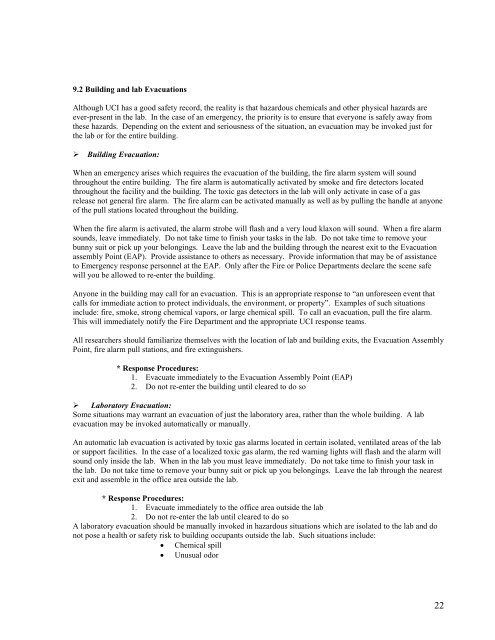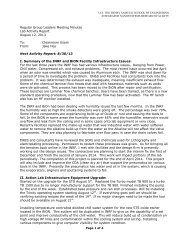Download Lab Safety Manual - Integrated Nanosystems Research ...
Download Lab Safety Manual - Integrated Nanosystems Research ...
Download Lab Safety Manual - Integrated Nanosystems Research ...
Create successful ePaper yourself
Turn your PDF publications into a flip-book with our unique Google optimized e-Paper software.
9.2 Building and lab Evacuations<br />
Although UCI has a good safety record, the reality is that hazardous chemicals and other physical hazards are<br />
ever-present in the lab. In the case of an emergency, the priority is to ensure that everyone is safely away from<br />
these hazards. Depending on the extent and seriousness of the situation, an evacuation may be invoked just for<br />
the lab or for the entire building.<br />
‣ Building Evacuation:<br />
When an emergency arises which requires the evacuation of the building, the fire alarm system will sound<br />
throughout the entire building. The fire alarm is automatically activated by smoke and fire detectors located<br />
throughout the facility and the building. The toxic gas detectors in the lab will only activate in case of a gas<br />
release not general fire alarm. The fire alarm can be activated manually as well as by pulling the handle at anyone<br />
of the pull stations located throughout the building.<br />
When the fire alarm is activated, the alarm strobe will flash and a very loud klaxon will sound. When a fire alarm<br />
sounds, leave immediately. Do not take time to finish your tasks in the lab. Do not take time to remove your<br />
bunny suit or pick up your belongings. Leave the lab and the building through the nearest exit to the Evacuation<br />
assembly Point (EAP). Provide assistance to others as necessary. Provide information that may be of assistance<br />
to Emergency response personnel at the EAP. Only after the Fire or Police Departments declare the scene safe<br />
will you be allowed to re-enter the building.<br />
Anyone in the building may call for an evacuation. This is an appropriate response to “an unforeseen event that<br />
calls for immediate action to protect individuals, the environment, or property”. Examples of such situations<br />
include: fire, smoke, strong chemical vapors, or large chemical spill. To call an evacuation, pull the fire alarm.<br />
This will immediately notify the Fire Department and the appropriate UCI response teams.<br />
All researchers should familiarize themselves with the location of lab and building exits, the Evacuation Assembly<br />
Point, fire alarm pull stations, and fire extinguishers.<br />
* Response Procedures:<br />
1. Evacuate immediately to the Evacuation Assembly Point (EAP)<br />
2. Do not re-enter the building until cleared to do so<br />
‣ <strong>Lab</strong>oratory Evacuation:<br />
Some situations may warrant an evacuation of just the laboratory area, rather than the whole building. A lab<br />
evacuation may be invoked automatically or manually.<br />
An automatic lab evacuation is activated by toxic gas alarms located in certain isolated, ventilated areas of the lab<br />
or support facilities. In the case of a localized toxic gas alarm, the red warning lights will flash and the alarm will<br />
sound only inside the lab. When in the lab you must leave immediately. Do not take time to finish your task in<br />
the lab. Do not take time to remove your bunny suit or pick up you belongings. Leave the lab through the nearest<br />
exit and assemble in the office area outside the lab.<br />
* Response Procedures:<br />
1. Evacuate immediately to the office area outside the lab<br />
2. Do not re-enter the lab until cleared to do so<br />
A laboratory evacuation should be manually invoked in hazardous situations which are isolated to the lab and do<br />
not pose a health or safety risk to building occupants outside the lab. Such situations include:<br />
• Chemical spill<br />
• Unusual odor<br />
22



